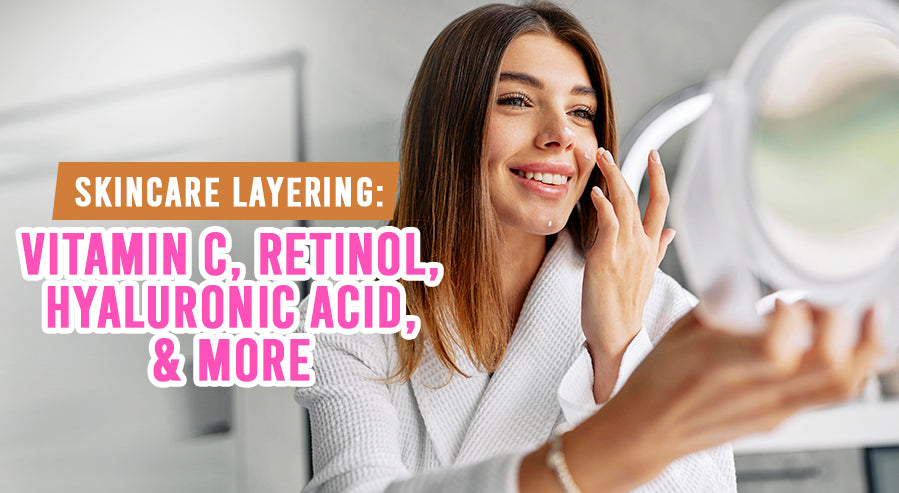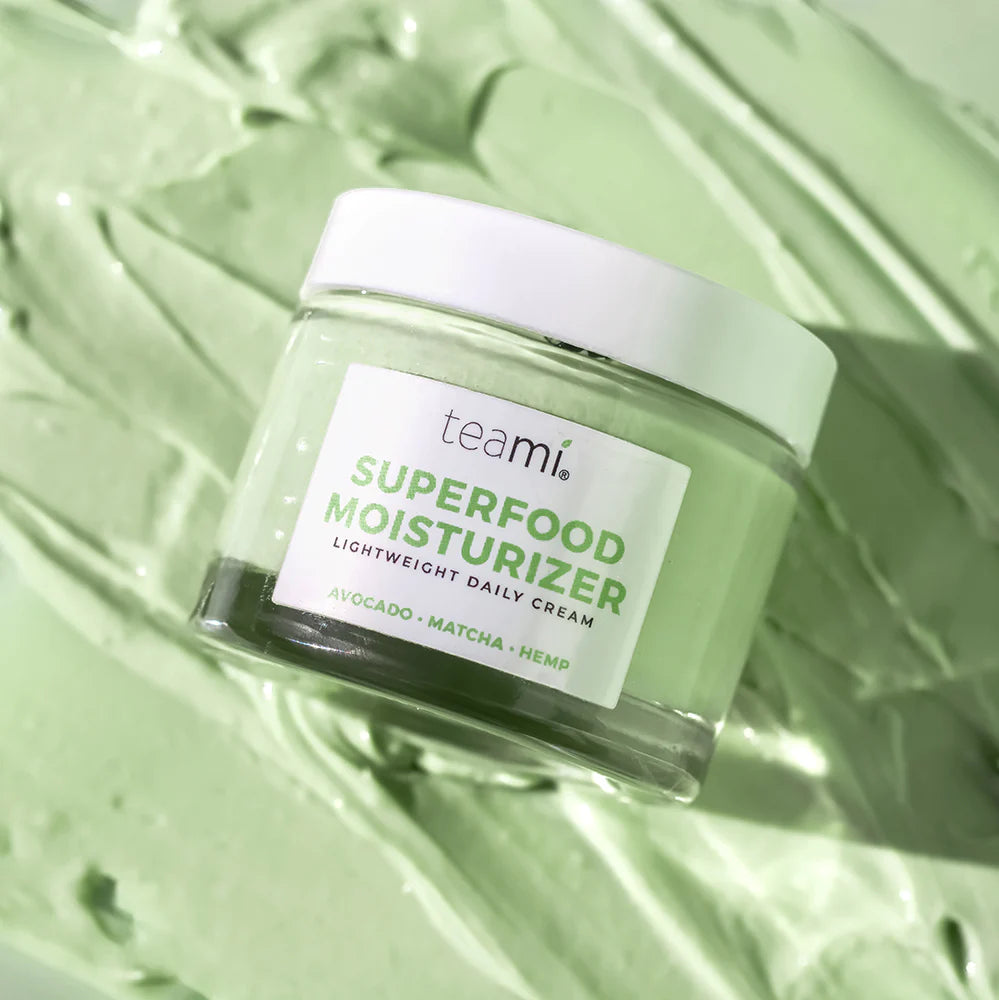Skincare Layering: Vitamin C, Retinol, Hyaluronic Acid, & More

Skincare is a very complicated process because our skin is, by nature, a complicated organ. As a result, taking care of it requires various tools, knowledge, and dedication to ensure we get the desired results. Often, the main skincare concern is ensuring we get the proper products to treat our skin for whatever blemishes or issues might affect it.
Unfortunately, finding the right product with the right ingredients is often the easiest step, and using them presents a greater challenge. Every skincare product has instructions on how to use them, what is inside them, and whether they will conflict with certain products or skin types. The thing people tend to overlook at first is that they must have an in-depth understanding of layering.
Applying the products per their instructions will be fruitless if you do not maintain proper layering when rejuvenating your skin. Skincare experts and beauty enthusiasts understand the concept of layering, but you might not know about it if you are just starting. Unfortunately, the lack of general education on how skincare layering works means beginners often make serious mistakes in the early stages of their efforts.
A lack of knowledge about how skincare layering works means your routine will, at best, not have any effect and, at worst, cause skin issues. The result of improper layering varies depending on how sensitive your skin is, but avoiding improper layering is always in your best interest. The question is: how does it work?
What is Skincare Layering?
Skincare layering is a special term used in the cosmetic industry that means using your products in the correct order. Most skincare products are sensitive and have delicate compositions that require them to be applied carefully to work. Without the proper application process, the products are doomed to fail and will not generate the desired effects.
One of the key details of proper application is ensuring you do not diminish the product's effect by applying it after a more powerful one. Some products need to be applied earlier in your routine for them to work and will synergize with the other products applied after it. This creates a hierarchy of layers for skincare products that must be followed for the best results.
Skincare layering is not overly complicated to follow, but the reasons it exists might be difficult to understand if you are not experienced with skincare products. Skincare layering ensures certain products and nutrients are not overpowered by something applied earlier. This works because the earliest applied product forms the bottom layer and is absorbed into the skin first. Meanwhile, anything applied after that first product will form subsequent layers that will be absorbed after the one before them.

There are more specific details about how this process works on a chemical level, but the details depend on what layer we are discussing. Fortunately, skincare layering is a well-defined concept that has established a baseline for the most common skincare products.
You likely already have multiple skincare products focusing on specific nutrients and substances that benefit the skin. Products like hyaluronic acid, niacinamide, and retinol are some of the most common tools in modern cosmetics and are either in your possession or on your shopping list. Skincare layering affects when each of these products should be applied in relation to each other. The question is: what is the proper order?
Layer #1: Vitamin C
Vitamin C is something we are told as children is good for us and will help us develop a healthy body. Those lectures from our parents were accurate since vitamin C is one of the most important nutrients for human development. While we tend to consume foods rich in vitamins to reap the internal benefits, other applications for vitamin C handle cosmetic concerns.
The cosmetics industry has refined vitamin C into serums that can be used in skincare routines for multiple reasons. The most important benefit of vitamin C insofar as skincare is concerned is that it hydrates the skin. In 2022, it was discovered that a variant of vitamin C, magnesium ascorbyl phosphate, has a hydrating effect on the skin. The same property was observed in traditional vitamin C serums, making them vital in maintaining healthy hydration levels.

Additionally, a 2017 review discovered that vitamin C impedes melanin production. Melanin is the chemical our bodies create to darken our skin in response to intense solar light. Unfortunately, some people have an issue with their melanin production that causes discoloration, making parts of their complexion darker than the rest.
Vitamin C's ability to impede melanin production means it can counteract hyperpigmentation and brighten the skin. These traits, among others, have turned vitamin C into a critical addition to modern skincare routines. As far as skincare layering is concerned, vitamin C should be the first layer you apply. Vitamin C gets the early treatment because it has a low pH value, meaning it is slightly acidic.
Many skincare products have a neutral pH, meaning they would neutralize the effects of the acidic substances before they have a chance to work. Applying a neutral pH product after a slightly acidic product means the latter will have a chance to do something, while the former prevents it from irritating your skin. Other acidic products also stabilize when exposed to vitamin C's pH. Therefore, vitamin C should always form the base layer of your skincare routine.
Layer #2: Hyaluronic Acid
You might have heard of hyaluronic acid in hair and skincare commercials, or you might have already used it for one or both of those purposes. Despite the name, hyaluronic acid is not the acid that will cause your skin to melt the second it touches you.
In fact, our bodies naturally produce hyaluronic acid with a particular focus on the eyes, joints, and skin. Hyaluronic acid is a natural resource our bodies need to maintain a healthy appearance and function, but it is not always as prevalent as we need it to be. The effects of hyaluronic acid on skin and hair have turned it into one of the main skincare products on the market. This is because hyaluronic acid has several potential effects that can enhance the health and quality of our skin.
One of the main benefits of hyaluronic acid is the same benefit offered by vitamin C, hydration. Hyaluronic acid excels at retaining water, an effect it passes onto your skin so you can maintain level hydration in the skin on your face and around your eyes. Hyaluronic acid has also been used to treat dry eyes since it can restore hydration around them. In addition to hydration, hyaluronic acid provides our skin with a resource that is more valuable to those of advanced age.

As we age, our skin loses elasticity and flexibility, manifesting signs of age in our complexions. The main example is wrinkles, a common sight for anyone in their 60s, though it can happen earlier. Hyaluronic acid helps the skin stretch more effectively and enhances its ability to flex despite the loss of collagen and general wear and tear. This means we can go longer without developing wrinkles and maintain our youthful complexion.
Additionally, evidence suggests that hyaluronic acid helps the skin recover from injuries by accelerating the healing process. This benefit means we are less likely to develop scars from minor wounds that would otherwise leave a permanent mark. Hyaluronic acid is so valuable that its place in the skincare layering hierarchy is one of the most important since it would be a shame to waste any.
Hyaluronic acid is generally applied after vitamin C, primarily because it has a more neutral pH than vitamin C. You might remember that we mentioned the need to apply higher pH substances sooner to avoid neutralizing them prematurely. Hyaluronic acid's lowest pH value is 5.0, whereas vitamin C's is 2.5, making the latter twice as acidic as hyaluronic acid. That said, hyaluronic acid is still acidic, meaning it takes priority over other substances.
Layer #3: Niacinamide
Niacinamide is a type of vitamin B-3 that our bodies need to maintain healthy skin, among other things. Niacinamide cream is often used to treat acne and inflammatory skin conditions. It also provides essential ceramides that improve epidermal health and appearance. Niacinamide is a common product usually found in most cosmetic stores or pharmacies, though natural niacinamide can be found in certain foods for people looking to avoid topical applications. Nevertheless, niacinamide is a valuable addition to your skincare routine but must be applied at a specific point in the skincare layering process.

Niacinamide should always be applied after any acidic substances since it helps preserve them long enough to work. This means it will take longer for neutral skincare products to neutralize them, and you can reap the benefits more effectively. Unfortunately, most of niacinamide's effects are lost when used with acidic substances. It is still valuable but is usually used to preserve vitamin C serums and hyaluronic acid creams in skincare routines.
Layer #4: Retinol
Retinol is an interesting skincare product generally used only in nighttime skincare routines rather than morning ones. Retinol addresses blemishes and skin damage that can affect anyone undergoing puberty. One of our main concerns in adolescence is acne, which is both unsightly and irritating. Unfortunately, it is unavoidable since our hormones go berserk during puberty, promoting bacterial colonization and excess sebum production.
Even when our acne is gone, severe cases can cause skin scarring that could create permanent reminders of one of the earliest blemishes we encounter. Fortunately, retinol can address these issues and has been used to unclog pores (another major cause of acne that affects us in adulthood). Retinol unclogging our pores reduces the risk of outbreaks and makes it possible to maintain a clear complexion.

Additionally, retinol can reduce swelling and inflammation, lowering the odds of developing acne scars. Unfortunately, retinol might not work on severe sunken or raised scars since they affect deeper layers of your skin.
Retinol can offer additional benefits for the pores and signs of aging, but the key to its use is knowing where it ranks in the skincare layering process. Retinol is applied after hyaluronic acid since retinol can irritate the skin when applied directly. Oddly enough, hyaluronic acid creates a buffer between your skin and the retinol, reducing irritation. That said, you must allow the hyaluronic acid to dry before you apply the retinol. If your skin is damp (i.e., from hyaluronic acid), you increase the risk of redness or dryness.
Layer #5: Hydroquinone
If you are the kind of person that performs their skincare routine at night, then there is an additional product you might use. Hydroquinone is a phenol that has become a common skincare tool worldwide that has several benefits for people looking to rejuvenate their complexion. Like vitamin C, hydroquinone can lighten the complexion and counteract hyperpigmentation symptoms.
The key detail about hydroquinone is that it tackles a wider range of discoloration causes than vitamin C. Hydroquinone can counteract hyperpigmentation caused by drug use, chemotherapy treatments, and inflammation from acne. Additionally, hydroquinone can reduce inflammation in beard follicles, reducing acne issues, and it is used as a pretreatment for chemical peels. Not everyone uses hydroquinone, which is almost exclusively used in nighttime skincare regimens. Nevertheless, it is subject to the hierarchy of skincare layering like any other product.

If you are using hydroquinone, it should be applied after your retinol cream if your hydroquinone is in moisturizer form. The substances do not conflict, but you must allow 30 minutes to pass before applying it since retinol is a potent product, and applying hydroquinone too soon could cause skin damage or irritation.
Finding the Right Blend
We at Teami know skincare layering is a complicated process that might take some time to get used to. Hopefully, the guidelines established here have helped you understand the process better so you can eliminate the guesswork. We can also offer some valuable tools you can use in your skincare routine that will help you preserve your complexion.

We recommend our Bright Dark Spot Serum or our Hibiscus Infused Vitamin C Serum for the initial layer. We also have an Overnight Sleep Mask containing niacinamide, hyaluronic acid, and vitamin C, which can rejuvenate your skin while you rest. We encourage you to visit our website and peruse our products directly so you can find the best one for your needs. After all, finding the right blend is a Teami effort.
Subscribe to our Newsletter
Subscribe to our newsletter and get 10% off your first purchase
 Instagram
Instagram



